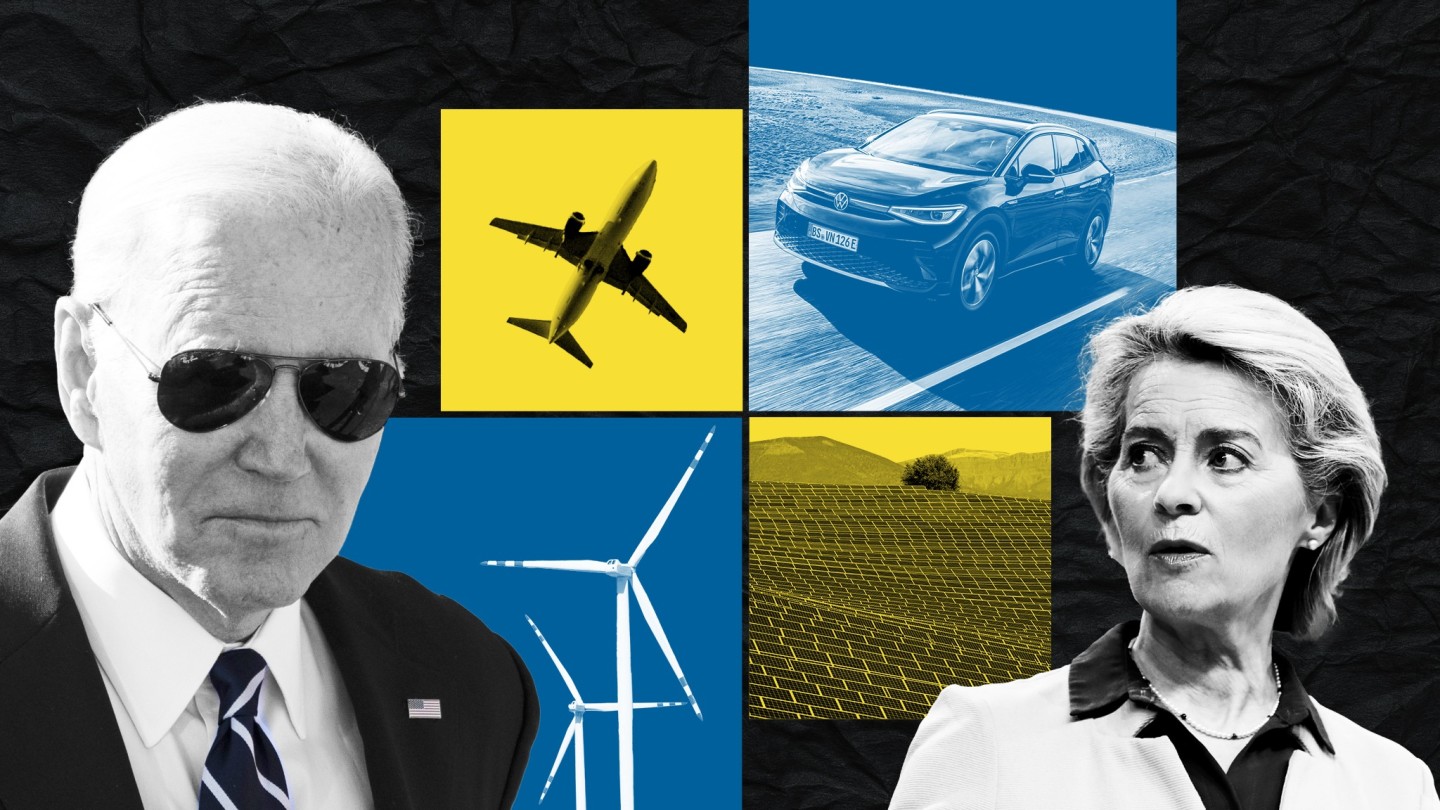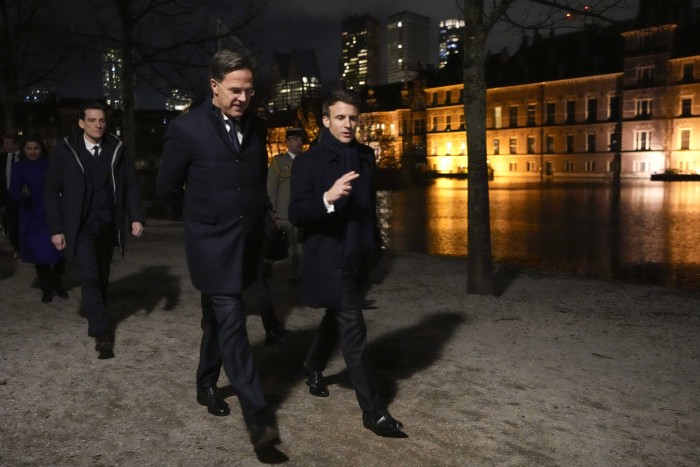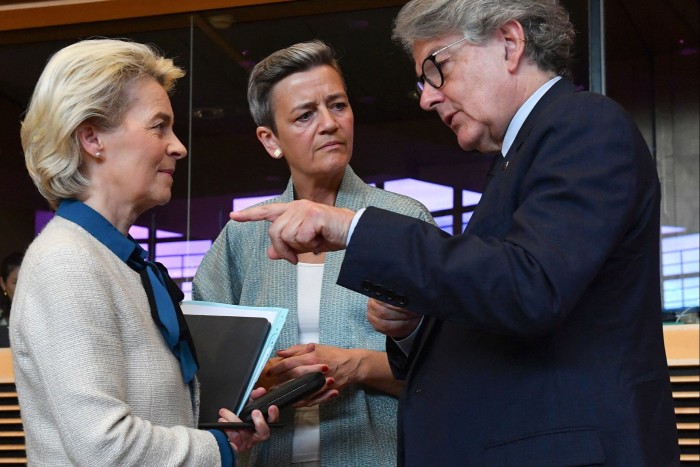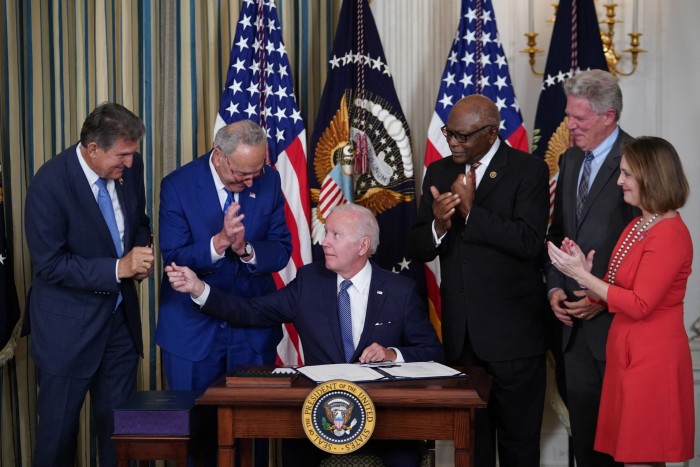
Donal O’Riain has been struck by the welcome his company received in the US — and it isn’t just the Christmas card sent by the Department of Energy official who is helping it secure federally supported loans.
The prospect of abundant government funding thanks to the Inflation Reduction Act is prompting Ecocem, an Irish low-carbon cement producer, to double a planned $120mn investment in California as it reorients spending towards the US instead of Europe, he says.
“They are rolling out the carpet for green investment — we were surprised at how personal the contact was,” says O’Riain, Ecocem’s founder and managing director. The “net effect” is that Ecocem, which qualifies for IRA funding on the basis that its cement is produced with carbon emissions that are 40 times lower than average, will “favour further investment in the States [rather] than in the EU”.
Cases like that of Ecocem are prompting a brutal reckoning in the EU, as heads of government prepare for a Brussels summit on February 9-10 aimed at figuring out how to respond to the massive subsidies and buy-America provisions being rolled out under the $369bn IRA. “Europe is in panic mode,” says Dutch MEP Paul Tang.
At stake are the very fundamentals of the EU’s economic model.
Since its inception, the single market has been based on the idea that a level playing field needs to be secured for both the wealthier and poorer nations, and strict limits are therefore needed on state aid that members offer their industries. But even before the US announced its green subsidies, the rules on state aid were already being watered down — in response to the pandemic and the impact of war in Ukraine.
France and its allies are pushing to further loosen the shackles on subsidies as part of an active industrial policy aimed at securing key supply lines, embedding the drive towards its climate objectives, and holding its own in the great power competition between the US and China.

But economic liberals in countries including Sweden and the Netherlands see a risk that Brussels will, in its rush to compete with the torrent of public cash available in the US and in China, end up “fragmenting” the single market by allowing big member states such as Germany and France even greater latitude to lavish cash on top companies. The IRA is, they fear, fuelling a wider push towards a more interventionist — some say protectionist — mindset in big economies.
Mark Rutte, the Dutch prime minister, is among those warning Europe must not “throw the baby [out] with the bathwater” as it attempts to concoct a convincing response to America’s legislation. “The idea of jumping to a sort of race to the bottom on state aid is not to our liking, because one of the most successful things in the European Union since 1957 is the internal market,” he tells the FT.
“If we make the wrong decisions it really could have long-term impact — far beyond this IRA thing.”
What makes the debate so difficult in Europe is the extent to which America itself has ditched fair-trade norms in its legislation, which provides tax credits and federal support to industries ranging from hydrogen and electric car batteries to solar panels and sustainable aviation fuel.
The IRA, which was agreed in a surprise political deal in Washington in August, offers companies billions of dollars, largely through tax credits, to boost investment in new and nascent clean energy technologies. Companies are rewarded for reorganising supply chains to be located either in the US or among allies and partners.
The EU says the IRA’s local-content requirements are incompatible with World Trade Organization rules that are meant to bar discrimination against products based on their country of origin. It has attempted to convince the US to cut European companies into the benefits, but talks within a US-EU task force on the topic have yielded only partial progress in the area of electric vehicles and batteries.
Ecocem is the type of company that Europe desperately wants to keep onshore. The EU is aiming to cut its greenhouse gas emissions by 55 per cent by 2030, compared to 1990 levels, while fighting an energy crisis brought on by dramatic cuts in supplies of gas from Russia.
On both fronts, the bloc needs every scrap of renewable energy and clean technology it can get. But it is competing in a global market where both the US and China are pouring hundreds of billions into green industries through state funding.
O’Riain says that in France, where Ecocem has two factories, the company received no public subsidies as they were not available at the time. State assistance, he adds, “means we can raise our horizons in terms of how fast we can scale.”
The question of state aid
The pressure on the EU single market has been building for some time.
Some EU diplomats and politicians argue the union has long been guilty of a naive approach towards its green industry by permitting China, in particular, to dominate critical sectors instead of nurturing Europe-based champions.
They cite the rampant growth of photovoltaic solar panel manufacturing in China a decade and a half ago. Brussels imposed anti-dumping duties on Beijing in 2013, alleging Chinese producers were getting unfair subsidies.

France is now leading the charge for a harder-headed approach to international trade and work on securing its own resilience and “sovereignty”. Paris in January demanded a “made in Europe” strategy in response to the IRA, entailing a reinforced European industrial policy and a far-reaching simplification of the EU’s state aid framework, which curbs government subsidies that could distort the single market.
Within the commission Thierry Breton, the French commissioner for the EU’s internal market, has championed the push for European “strategic autonomy” in industries from pharmaceuticals and semiconductors to critical raw materials. “It is high time to reconcile climate neutrality policy with industrial competitiveness policy,” he said on Friday during a trip to Washington.
Three commissioners from free-market minded countries — Margrethe Vestager of Denmark, Valdis Dombrovskis of Latvia and Frans Timmermans of the Netherlands — are pushing back, writing in the Financial Times last week that the EU should focus on creating a “business-friendly environment” while maintaining its “open approach to global trade”.
Vestager, the EU’s competition commissioner, is due to unveil state aid proposals on Wednesday as part of a wider set of policies aiming to streamline permitting for new green projects and easing payments of EU money. She tells the FT that changes needed to be “focused”, arguing it was only in a few sectors that there was an “acute risk” of investment shifting from the EU to the US.
“If the state leads this transition then on some occasions state aid is also legitimate, as long as no one then jumps to the conclusion to say ‘well, let the taxpayer do everything,’” she says. “Without private investment, it’s not going to happen.”
The prospect of a further loosening in state aid controls has, however, caused deep disquiet this week among some senior competition officials in Brussels, where some fear the floodgates are opening on public subsidies in Europe.
They complain these “temporary” relaxations of its state aid rules are becoming a persistent habit. Brussels pushed through a time-limited loosening early in the Covid-19 crisis, but then followed that up last year with further flexibility in response to the Russian invasion of Ukraine and the energy crisis. Constraints will be eased for the semiconductor industry via the proposed European Chips Act.
“There is a joke that nothing is more permanent than temporary things,” says one EU official. “This temporariness is starting to last.”
The results of these relaxations of subsidy restraints have been hugely imbalanced. EU member states have won approval for €672bn subsidies under the bloc’s temporary crisis framework, of which no less than 53 per cent has been notified by Germany, the EU’s biggest economy, equating to around 9 per cent of its annual gross domestic product.
France’s share stands at 24 per cent, or just above 6 per cent of GDP, while fiscally stretched Italy sought approval for only around 7 per cent of the total — equalling less than 3 per cent of GDP.
Specialists say this contributes to a deeper fragmentation between EU countries and indeed regions. Craig Douglas, the founder of World Fund, a €350mn venture fund based in Berlin, says the discrepancies between the “specific buckets of capital” available in Europe are sharp. “If I want to build a manufacturing facility in Aachen or Bavaria there is more regional capital available than doing it in Paris.”
Unlocking the money
The debate over state aid is reawakening a related dispute over how to fund subsidies.
European countries with strained public finances insist that any loosening of state aid constraints needs to be balanced by the creation of a big new EU-wide pot of cash to help to support member states with limited fiscal resources. Some, including Italy, are pushing for much more flexibility in how they can deploy existing EU funding.
Germany, the Netherlands and other fiscally conservative states are, however, fully prepared to block any additional common EU borrowing, meaning any fresh cash on tap is likely to be modest.
They argue the bloc already has ample funding available for its green transition, and that it is the US that is playing catch-up with Europe’s existing initiatives. Back in 2020, for example, across the EU some €81bn was forked out to subsidise renewables, according to commission figures.

That has been enhanced by the €800bn NextGenerationEU Covid-19 recovery programme, under which capitals are required to commit at least 37 per cent of spending to the green transition. On top of that, about €100bn of the EU’s 2021-27 cohesion spending, which boosts regional development, is expected to be green.
While the IRA’s widely heralded consumer subsidies on US electric vehicles amount to $7,500, figures from the European Automobile Manufacturers’ Association and Bruegel show that the average in the EU is not actually that far behind, at the equivalent of $6,500.
Part of the EU response to be discussed at next week’s summit will be making it easier to redirect pots of EU money to specifically respond to the IRA.
Some EU companies fear Brussels is going to be too cautious in its response. Ilham Kadri, chief executive of Solvay, the Belgian chemicals company, says her company is already benefiting from funds from the Inflation Reduction Act, plus the state of Georgia has also committed to $27mn of state and local tax incentives.
Her experience of getting subsidies in France, by contrast, was a “long, tough journey”, she says, with a lot of bureaucracy “for almost, I would say, nothing”. Europe, she says, needs to “wake up” and address not only state aid limits but also lengthy regulatory processes.
Kadri’s experience illustrates a problem many executives complain of in the EU regime: the sheer complexity of applying for the pots of cash scattered between different EU, national and regional programmes.
The IRA distributes support via simple-to-obtain tax credits, which are something Brussels has no power to hand out given tax is a national competence.
Vaitea Cowan, co-founder of Enapter, which has patented technology to produce green hydrogen, says she would need four people full time on her team just to understand what the EU had to offer in terms of funding and how they could access support.
“The support schemes just for renewable hydrogen are extremely hard to navigate,” she says, ranging from the European Investment Bank to the Horizon science programme. “There are so many of them . . . we need Europe to have much more pragmatism.”
EU funding also seems to favour industry incumbents rather than innovative start-ups. The first call-up for large-scale projects in 2020 through its Innovation Fund received 311 applications, from which seven grants were awarded — all to projects led by large companies including BASF, a multinational chemical company, and the Italian energy company Enel.
Cleantech for Europe, an industry body for green technology start-ups, noted that this represents a 2 per cent success rate for applicants. Projects that had been selected mostly focused on the carbon capture and storage, a technology which sets out to remove carbon produced by fossil fuels, rather than projects that would prevent the emission of carbon dioxide in the first place.
Top EU officials readily admit permitting processes for new installations take far too long. Jules Besnainou, Cleantech for Europe’s executive director, warns that there is a risk of “leakage” of clean tech industries out of Europe “no matter what”. The question, he says, is whether the EU response comes in time to scale up these industries, or “do we just lose them?”
A broader strategy
Europe’s economic liberals argue a lot of the wrangling over public subsidies misses the wider point.
Countries such as Sweden, which holds the EU’s rotating presidency, want the EU to focus instead on underlying competitiveness, loosening regulatory constraints and boosting fundamentals such as worker skills, rather than looking for ways of marshalling more public money.
Financing reforms might help. Delivering on the EU’s carbon reduction objectives requires additional investment of €520bn a year in 2021-2030, according to the commission, the majority of which will have to come from the private sector.
Yet the continent remains heavily reliant on bank-provided finance, while its attempts to forge stronger and more vibrant capital markets are proceeding at a snail’s pace.
Any adjustments to the state aid regime or creation of new EU resources must go “hand in hand” with reforms to the internal market, argues Cecilia Malmström, the EU’s trade commissioner from 2014 to 2019, plus a drive to conclude more trade deals. It would be a “dangerous path” to engage in a tit-for-tat response to the IRA, she says.
But the EU’s band of free-market cheerleaders feels embattled, especially following the departure of one of the UK, which had been one of their most vocal members. Plaintive references to WTO norms sound out of touch with the great power competition driving the world economy, embodied by the “decoupling” from China driven first by President Donald Trump and continued by his successor Joe Biden.
“Even the more liberal ones in the flock realise the world has changed,” says one senior EU official. When it comes to the IRA, the message from Washington is “just do the same as us, because we are not going to change anything”.
Data visualisation by Chris Campbell








